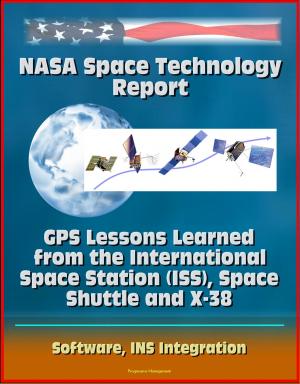Vision to Victory: Space, Mahan, and Mitchell: The Role of the Visionary in Cross-Organizational Innovation, Space Militarization Analog to Mahanian Modern Navy and Mitchell's Independent Air Force
Nonfiction, Science & Nature, Technology, Aeronautics & Astronautics, History, Military, Aviation| Author: | Progressive Management | ISBN: | 9781310100123 |
| Publisher: | Progressive Management | Publication: | May 27, 2016 |
| Imprint: | Smashwords Edition | Language: | English |
| Author: | Progressive Management |
| ISBN: | 9781310100123 |
| Publisher: | Progressive Management |
| Publication: | May 27, 2016 |
| Imprint: | Smashwords Edition |
| Language: | English |
This excellent report has been professionally converted for accurate flowing-text e-book format reproduction. Accomplishing the space changes needed in the future requires a major national security (MNS) change. The term MNS change is coined in this thesis to define a change that requires multiple Departments of the United States government to alter their internal functions. MNS change is, by definition, a cross-organizational change.
In this light, this thesis expands upon existing military innovation thought by using the concept of strategic vision to investigate the role of the visionary in MNS change. The initial hypothesis is that the cross-organizational nature of MNS change makes it more difficult to accomplish than innovation within a single organization. In order to investigate this hypothesis, a tailored step-by-step model for effective visionary leadership is developed by adapting existing vision models found in strategic management literature. The adaptation is necessary to overcome the limits of existing models, which are largely focused on a single organization. After establishing the necessary visionary framework, the framework is employed to systematically evaluate the historic changes to the US security structure brought about by the movements commonly associated with Alfred Thayer Mahan and William "Billy" Mitchell. The Mahanian vision led the US to develop a modern navy while Mitchell's vision led to an independent US Air Force. The results from the case studies are used to clarify the role of the visionary in MNS change as well as the relative importance of a visionary to other previously identified factors associated with military innovation.
The thesis draws three main conclusions. First, MNS change does represent a unique category of change and it is more difficult to achieve than is single organizational innovation. Second, the visionary plays a necessary but not sufficient role in this process largely because of the need for human judgment and the need to bridge between organizations. Third, major national security change may also require a change in the national security strategy before a vision becomes achievable.
Why, in 42 years, has space not gained the prominence many thoughts it should? What can be done to focus and accelerate progress? Where can one look for answers? Rather than answer these questions directly, this thesis examines the visionary efforts of Alfred Thayer Mahan and William "Billy" Mitchell to clarify the role of the visionary in precipitating major cross-organizational military change. From a theoretical perspective, it attempts to establish the relative role of the visionary vis-a-vis previously identified factors associated with military innovation. Directly stated, this work endeavors to address the following questions. What is a vision? How is a vision created, communicated, and executed? How does a vision for major national security change differ from the standard conception of a vision? How did Mahan and Mitchell develop as visionaries? What was the key factors influencing their development? Why have America's most prominent visionaries generally not been the formal leaders of their services? What is the role of the visionary in major national security change? How important is a visionary relative to other change-related factors? Is a visionary essential to major national security military change? Is a space visionary required to bring about major change in the role space plays in American security?
This excellent report has been professionally converted for accurate flowing-text e-book format reproduction. Accomplishing the space changes needed in the future requires a major national security (MNS) change. The term MNS change is coined in this thesis to define a change that requires multiple Departments of the United States government to alter their internal functions. MNS change is, by definition, a cross-organizational change.
In this light, this thesis expands upon existing military innovation thought by using the concept of strategic vision to investigate the role of the visionary in MNS change. The initial hypothesis is that the cross-organizational nature of MNS change makes it more difficult to accomplish than innovation within a single organization. In order to investigate this hypothesis, a tailored step-by-step model for effective visionary leadership is developed by adapting existing vision models found in strategic management literature. The adaptation is necessary to overcome the limits of existing models, which are largely focused on a single organization. After establishing the necessary visionary framework, the framework is employed to systematically evaluate the historic changes to the US security structure brought about by the movements commonly associated with Alfred Thayer Mahan and William "Billy" Mitchell. The Mahanian vision led the US to develop a modern navy while Mitchell's vision led to an independent US Air Force. The results from the case studies are used to clarify the role of the visionary in MNS change as well as the relative importance of a visionary to other previously identified factors associated with military innovation.
The thesis draws three main conclusions. First, MNS change does represent a unique category of change and it is more difficult to achieve than is single organizational innovation. Second, the visionary plays a necessary but not sufficient role in this process largely because of the need for human judgment and the need to bridge between organizations. Third, major national security change may also require a change in the national security strategy before a vision becomes achievable.
Why, in 42 years, has space not gained the prominence many thoughts it should? What can be done to focus and accelerate progress? Where can one look for answers? Rather than answer these questions directly, this thesis examines the visionary efforts of Alfred Thayer Mahan and William "Billy" Mitchell to clarify the role of the visionary in precipitating major cross-organizational military change. From a theoretical perspective, it attempts to establish the relative role of the visionary vis-a-vis previously identified factors associated with military innovation. Directly stated, this work endeavors to address the following questions. What is a vision? How is a vision created, communicated, and executed? How does a vision for major national security change differ from the standard conception of a vision? How did Mahan and Mitchell develop as visionaries? What was the key factors influencing their development? Why have America's most prominent visionaries generally not been the formal leaders of their services? What is the role of the visionary in major national security change? How important is a visionary relative to other change-related factors? Is a visionary essential to major national security military change? Is a space visionary required to bring about major change in the role space plays in American security?















